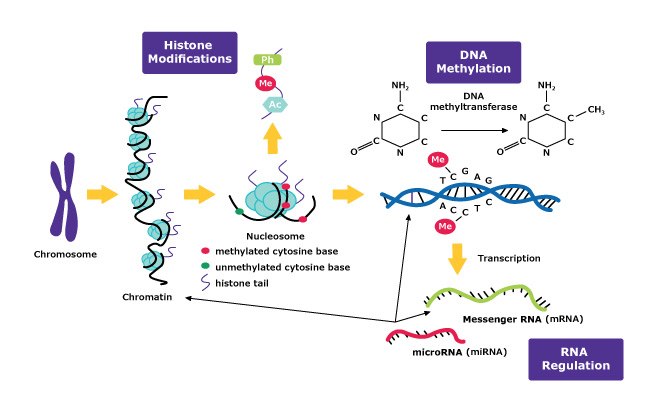表观遗传学

表观遗传学领域已经成为从事癌症、神经退行性疾病和成瘾研究的科学家关注的重要领域。表观遗传机制涉及暂时激活或抑制基因表达。值得关注的是,即使这些变化不会永久改变DNA序列,也可以代代相传。表观遗传学的三个主要机制是DNA甲基化、组蛋白修饰和RNA调控。
DNA甲基化
DNA甲基化是最广为人知的表观遗传机制。DNA甲基化通常涉及甲基转移酶,利用这种酶可在胞嘧啶的第五个位点(C5)增加一个甲基。这一甲基主要加在胞嘧啶-磷酸-鸟嘌呤(CpG)二核苷酸上,但也存在非CpG甲基化的情况。为此,常常需要进行DNA甲基化分析以帮助理解基因表达。这类分析的示例包括:酶解DNA,然后通过HPLC、质谱分析定量甲基化;或者使用硫酸氢钠转化,然后再进行PCR测序和分析。
组蛋白修饰
组蛋白修饰是另一种经典的表观遗传机制。组蛋白修饰涉及多种改变组蛋白的方式,包括乙酰化、甲基化、磷酸化和其他影响基因表达的机制。组蛋白是可与DNA一起构成核小体的一类蛋白质。成束的核小体形成染色质,构成染色体。通常,组蛋白修饰发生组蛋白N末端尾部,氨基酸赖氨酸或精氨酸发生的比例较高。研究这种表观遗传调控的一种方法是染色质免疫共沉淀(ChIP)检测。
RNA 调控
与其他表观遗传机制相比,研究人员对RNA调控的了解甚少。人们普遍认为,RNA信号传导通过调节染色质结构影响表观遗传。目前学界研究人员正在研究mRNA——特别是非编码RNA(例如长链非编码RNA和微RNA)——在调控基因表达方面发挥的作用。此外,我们还可通过RNA纯化染色质分离(ChIRP)或RNA免疫沉淀(RIP)技术了解染色质与RNA之间的关系以及RNA的表观遗传学作用。
相关技术文章
- Epigenetic modifications are thought to occur through two key interconnected processes—DNA methylation and the covalent modification of histones.
- Epigenetic regulation starts with DNA wound around a set of completely acetylated histones associated with an activated, fully transcribed gene.
- p53 regulates gene expression, cell cycle control and functions as a tumor suppressor. Inactivation of p53 is closely tied to cancer development.
- The Imprint DNA Modification Kit provides the reagents needed for bisulfite conversion and post-modification clean-up of DNA samples in less than 2 hours.
- Epigenetics is a term coined to describe changes that are not mutation based but can still be passed on from generation to generation. Genes that are activated or repressed without any change in DNA sequence are epigenetically controlled. Epigenetic modifications are stable, but potentially reversible alterations in gene expression that occur without permanent changes in DNA sequence.
- 查看完整内容 (14)
相关实验方案
- To prevent nonspecific binding of the analyzed protein or extract to the DNA fragment or oligonucleotide, nonspecific competitor nucleic acid is added to the binding reaction.
- The Imprint® Methylated DNA Quantification Kit provides a high-throughput, non-radioactive means of measuring global DNA methylation shifts.
- Chromatin Immunoprecipitation quantitative real-time PCR (ChIP-qPCR) is commonly used in studies that focus on specific genes and potential regulatory regions across differing experimental conditions and data analysis. qPCR enables DNA analysis in real time by analyzing fluorescent signal intensities that are proportional to the amount of amplicon.
- Protocol for Chromatin Isolation by RNA Purification (ChIRP) Protocol
- The Sigma Imprint Chromatin Immunoprecipitation Kit uses a plate based system to allow rapid ChIP assays in a high throughput format
- 查看完整内容 (5)
登录以继续。
如要继续阅读,请登录或创建帐户。
暂无帐户?